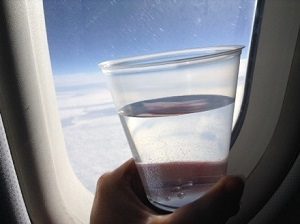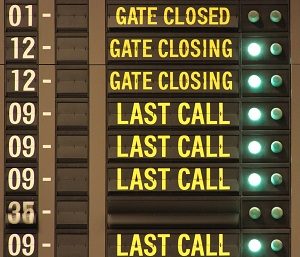I am about to embark on an overseas trip to Europe, and as I have had a pulmonary embolus on a plane myself I thought it was sensible to review what precautions I should take to avoid another one. As a doctor I like to base my advice on solid reliable data, but unfortunately there are very few studies about the risks of thrombosis relating to flying and the advice about what to do to reduce your risk of a blood clot is largely based on the opinion of experts. I recommend the following:
- Exercise.
 It is well know from studies in hospital that immobility such as lying in bed increases the risk of blood clot, so it is reasonable to assume that sitting still for a long time will make clots more likely. The risk is probably even higher if you block the blood flow to your legs by sitting in an awkward position. I am quite tall and find it difficult to get into a comfortable position when trying to sleep in economy. I often find my leg has “gone to sleep” because of the position I am in. Ideally I would recommend that you get up and walk around the plane every couple of hours but if you can’t easily get out of your seat it is important to at least move your feet up and down to exercise your calf muscles.
It is well know from studies in hospital that immobility such as lying in bed increases the risk of blood clot, so it is reasonable to assume that sitting still for a long time will make clots more likely. The risk is probably even higher if you block the blood flow to your legs by sitting in an awkward position. I am quite tall and find it difficult to get into a comfortable position when trying to sleep in economy. I often find my leg has “gone to sleep” because of the position I am in. Ideally I would recommend that you get up and walk around the plane every couple of hours but if you can’t easily get out of your seat it is important to at least move your feet up and down to exercise your calf muscles.
- Drink plenty of fluid.
 The air humidity on a plane is very low and quoted at around 15%, which is lower than most deserts; as a result you lose water very rapidly and can easily become dehydrated. If you are very dry the blood flow in your legs can slow down, so I recommend that you drink frequently. Always accept a drink when the flight attendants come around with water and if possible take extra water on board with you.
The air humidity on a plane is very low and quoted at around 15%, which is lower than most deserts; as a result you lose water very rapidly and can easily become dehydrated. If you are very dry the blood flow in your legs can slow down, so I recommend that you drink frequently. Always accept a drink when the flight attendants come around with water and if possible take extra water on board with you.
- Don’t drink alcohol
 Do not drink too much alcohol as this has a tendency to dehydrate you. If you are also taking diuretic medication it is even more important to keep up the fluids. The air quality is improving on aircraft, the new Boeing 787 Dreamliner has the best air quality with higher humidity in the cabin.
Do not drink too much alcohol as this has a tendency to dehydrate you. If you are also taking diuretic medication it is even more important to keep up the fluids. The air quality is improving on aircraft, the new Boeing 787 Dreamliner has the best air quality with higher humidity in the cabin.
- Take short flights
 The risk of DVT appears to be highest after long-haul flights of over 10,000km, that is about an 8 to 10 hour flight. The risk of a blood clot is very small for flights of only 3 to 4 hours. Therefore if possible break your journey with an opportunity to get some exercise between flights. Go for a walk around the airport during a stop-over; do more than just wander around the duty-free shop! (aimed at Angela).
The risk of DVT appears to be highest after long-haul flights of over 10,000km, that is about an 8 to 10 hour flight. The risk of a blood clot is very small for flights of only 3 to 4 hours. Therefore if possible break your journey with an opportunity to get some exercise between flights. Go for a walk around the airport during a stop-over; do more than just wander around the duty-free shop! (aimed at Angela).
- Wear flight socks
 Flight socks (like these snazzy blue ones from amazon) do two things; they reduce ankle swelling allowing you to move your feet more easily and they compress the superficial veins in the skin forcing the blood to go through the deeper vessels, this speeds up the blood flow in the deep veins and reduces the risk of clotting. On a plane a number of changes take place in your circulation that alter blood flow and blood clotting. Most modern aircraft fly at around 35,000 to 38,000 feet. At this altitude the cabin is pressurised to the equivalent of being at 5,000 to 8,000 feet. The change in pressure is thought to be part of the reason your ankles swell. In addition the oxygen level is lower than at ground level and in most people the blood oxygen saturation falls by about 4 %. This might not sound like much but for some people it can put a slight strain on their heart with a slight increase in the heart rate and cause minor fluid retention, again making your ankles swell. The low oxygen level also make your blood vessels slightly more permeable so more fluid can leak out and a low oxygen level makes your blood clot slightly faster. Flight socks certainly reduce swelling and increase blood flow, however some people find them very uncomfortable especially if they are not well fitted and dig into the calf. There have also been reports that people with varicose veins or a history of thrombophlebitis can get superficial vein problems. Compression stockings should not be used if you have a history of peripheral arterial disease.
Flight socks (like these snazzy blue ones from amazon) do two things; they reduce ankle swelling allowing you to move your feet more easily and they compress the superficial veins in the skin forcing the blood to go through the deeper vessels, this speeds up the blood flow in the deep veins and reduces the risk of clotting. On a plane a number of changes take place in your circulation that alter blood flow and blood clotting. Most modern aircraft fly at around 35,000 to 38,000 feet. At this altitude the cabin is pressurised to the equivalent of being at 5,000 to 8,000 feet. The change in pressure is thought to be part of the reason your ankles swell. In addition the oxygen level is lower than at ground level and in most people the blood oxygen saturation falls by about 4 %. This might not sound like much but for some people it can put a slight strain on their heart with a slight increase in the heart rate and cause minor fluid retention, again making your ankles swell. The low oxygen level also make your blood vessels slightly more permeable so more fluid can leak out and a low oxygen level makes your blood clot slightly faster. Flight socks certainly reduce swelling and increase blood flow, however some people find them very uncomfortable especially if they are not well fitted and dig into the calf. There have also been reports that people with varicose veins or a history of thrombophlebitis can get superficial vein problems. Compression stockings should not be used if you have a history of peripheral arterial disease.
- Take your medication
 If you are taking an anticoagulant, make sure you remember to take your medication regularly before a flight and for several days after. If you are not on anticoagulants and have had a clot previously, especially if it occurred for no obvious reason, you might want to talk to your doctor about the need for treatment before a flight. For my high risk patients I recommended a single injection of low molecular weight heparin immediately before the flight and prior to any leg of the journey of more than 10 hours. However you must discuss this with your doctor as he or she will know your medical history and will know if anticoagulant treatment is safe for you.
If you are taking an anticoagulant, make sure you remember to take your medication regularly before a flight and for several days after. If you are not on anticoagulants and have had a clot previously, especially if it occurred for no obvious reason, you might want to talk to your doctor about the need for treatment before a flight. For my high risk patients I recommended a single injection of low molecular weight heparin immediately before the flight and prior to any leg of the journey of more than 10 hours. However you must discuss this with your doctor as he or she will know your medical history and will know if anticoagulant treatment is safe for you.
- Don’t take aspirin
 Obviously if you are already taking aspirin you should continue to take it, but if you have never taken aspirin the expert consensus is that it is safer avoided. Although aspirin has an effect on coagulation there is no good evidence that it reduces the risk of clots and it is associated with an increased risk of gastric irritation and bleeding in the stomach, obviously a major bleed could spoil your holiday even if it makes it memorable!
Obviously if you are already taking aspirin you should continue to take it, but if you have never taken aspirin the expert consensus is that it is safer avoided. Although aspirin has an effect on coagulation there is no good evidence that it reduces the risk of clots and it is associated with an increased risk of gastric irritation and bleeding in the stomach, obviously a major bleed could spoil your holiday even if it makes it memorable!
- Fly business class.
 People in business class are not exempt from blood clots but the risk is probably lower. There is also some evidence that the risk is lower if you have an aisle seat rather than a window seat.
People in business class are not exempt from blood clots but the risk is probably lower. There is also some evidence that the risk is lower if you have an aisle seat rather than a window seat.
- Don’t be too worried.
 Serious blood clots associated with air flights are rare and if you are already on anticoagulants your chance of another event is very low.
Serious blood clots associated with air flights are rare and if you are already on anticoagulants your chance of another event is very low.
Enjoy your flight!

I do wear compression socks on long haul but are they really necessary on flights of three to four hours if I’m already taking anticoagulants?
Hi Janet. The risk of a clot on a short flight is low, and as you are taking anticoagulants you probably have a lower risk than most people on the plane. Compression stockings probably add nothing for a short flight.
Obviously if you have compression stockings and you find them comfortable they will not do you any harm and might stop your feet swelling, but I don’t believe there is any evidence they are beneficial on a short flights.